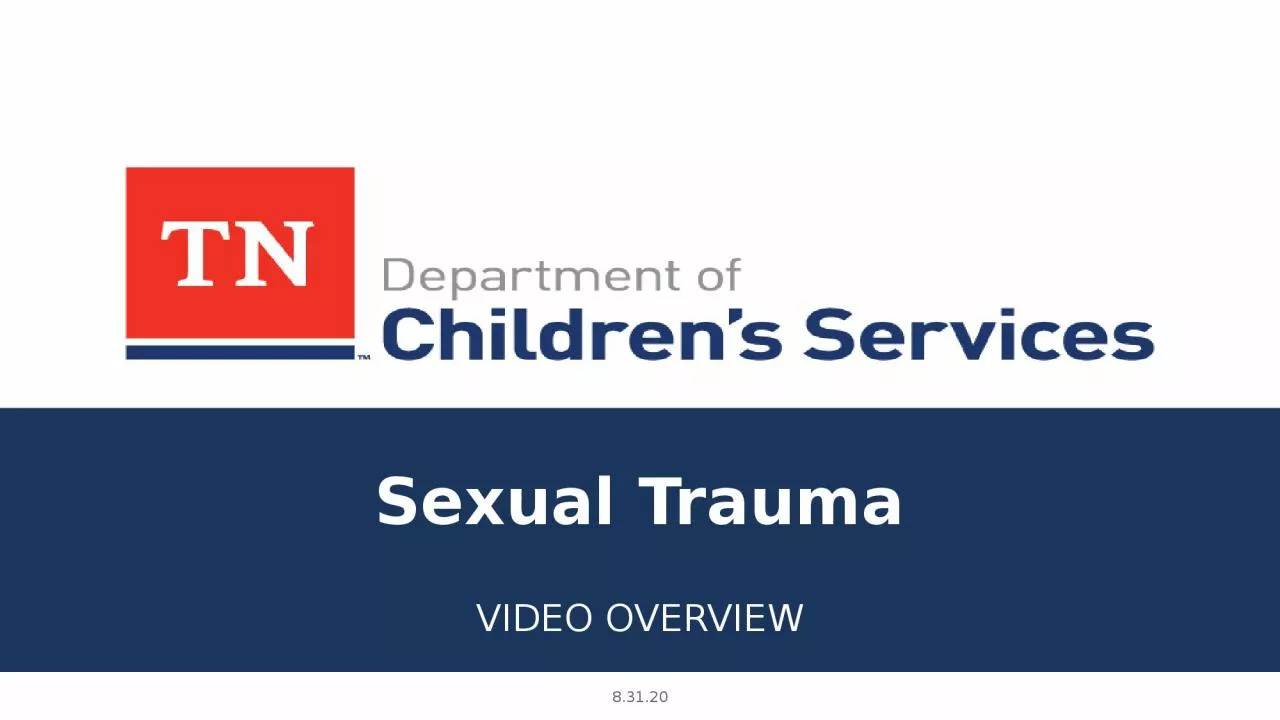

83120 Right Time Training Sexual Trauma Purpose of this Learning Opportunity The purpose of this training is to enhance your learning around sexual abuse and how to parent a child who has been sexually abused ID: 928529
Download Presentation The PPT/PDF document "Sexual Trauma VIDEO OVERVIEW" is the property of its rightful owner. Permission is granted to download and print the materials on this web site for personal, non-commercial use only, and to display it on your personal computer provided you do not modify the materials and that you retain all copyright notices contained in the materials. By downloading content from our website, you accept the terms of this agreement.
Slide1
Sexual Trauma
VIDEO OVERVIEW
8.31.20
Slide2Right Time Training:
Sexual Trauma
Slide3Purpose of this Learning Opportunity
The purpose of this training is to enhance your learning around sexual abuse and how to parent a child who has been sexually abused.
•Sexual abuse is something that some children who are in foster care or have been adopted have endured. Sexual abuse is not always known when children enter the child welfare system.
•Some parents are concerned about parenting children who have been sexually abused. However, it is important to know that parenting a child who has been sexually abused is very doable. By providing a safe and nurturing home, parents who are fostering or adopting can help children to thrive and recover.
Slide4Objectives
▶ Learn the risk factors and indicators of sexual abuse
▶ Learn how to creating an Emotionally Safe Environment
▶ Identify strategies to keep Children safe and prevent further abuse
▶ Identify ways to promote healthy sexually development
Slide5Pre-Video Discussion
▶ What are typical behaviors that children who have been sexually abused might exhibit??
▶ Why don't children tell someone that they have been or are being sexually abused?
Slide6Risk Factors and Indicators of Sexual Abuse
To recognize signs of sexual abuse, it's helpful to know typical sexual development. Like all development, sexual development varies from child to child. It is typical for all children to do some exploration and have curiosity about their bodies, sex, feelings, discoveries, attractions, and behaviors.
Slide7Risk Factors and Indicators of Sexual Abuse Cont’d
There are certain things that increase a child's risk of sexual abuse, such as:
1.
Neglect of the child
2. A parent who is abusing drugs/alcohol
3. A parent with mental illness
4. A home characterized by chaos
5. When the child is living from place to place
Slide8Potential Indicators
Parents who are fostering or adopting may not know a child's abuse history when they come into the home. As a result, it is important to pay attention to the child's behaviors.
Play that involves sexual themes
Imitating sex acts with siblings or other children
Sexual Knowledge above their age
Sexually Reactive Behaviors
Slide9Creating an Emotionally Safe Environment
The most important thing to do if you see or hear signs of sexual abuse is to remain calm, stay open, and get curious
It is important to listen and be there for the child. If the child says something that indicates they have or are experiencing sexual abuse, give them your 100% attention.
It is important to validate the child's feelings and believe the child even if it does not all make sense.
Inform a professional
Slide10Creating an Emotionally Safe Environment Cont
’d
Understand that children have many reasons why they may not share about their sexual abuse, at least not right away or in full.
Younger children often worry they will get in trouble.
Older children usually experience a lot of shame and guilt about "letting" it happen.
It can be confusing for some children because some of it might have felt good, which can be scary and confusing to them because it makes them wonder if they wanted the abuse.
Slide11Strategies to Keep Children Safe and Prevent Further Abuse
Develop a safe, supportive relationship with the child where the child feels comfortable telling you things
Have ongoing, open conversations with the child about sexual development as you would with any other topic such as how to manage money or the importance of having manners.
Educate children as early as possible about what consent means and what it looks like
Your voice needs to be the one that is heard the most.
Slide12Promoting Healthy Sexual Development
It is important to have regular conversations about sexual development before adolescence and romantic relationships begin.
It is important to keep talking and educating teenagers so they do not become vulnerable again (for example, reviewing what consent means).
Help children who have experienced abuse to see themselves as survivors rather than victims or "damaged goods".
Slide13Post-Video Discussion
Childhood sexual abuse has been linked to many physical, social, cognitive, and emotional problems, including a very high risk of being sexually hurt again. A family's love and protection helps to lower this risk. The more we acknowledge, the more we believe them, the more we reinforce that it is never their fault; and make it clear that sexual abuse is never ok, then the more we can keep their self-image positive.
Slide14Q & A
What are two ways a perpetrator can attempt to transfer responsibility for the abuse to a child?
What are some things parents can teach children in order to reduce their risk of being sexually abused or revictimized?
How can you practice and model consent with children in your care?
Slide15Thank you for Joining!